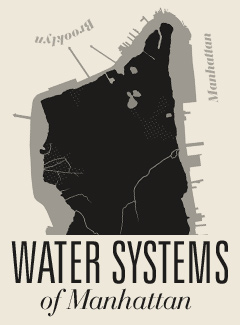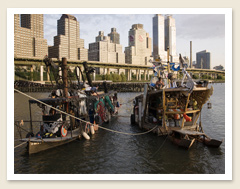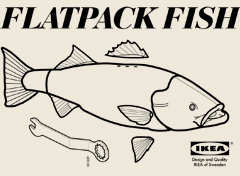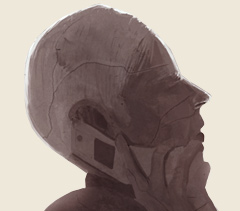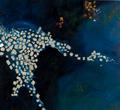The Sick Waters
of Voronezh
by VADIM NIKITIN
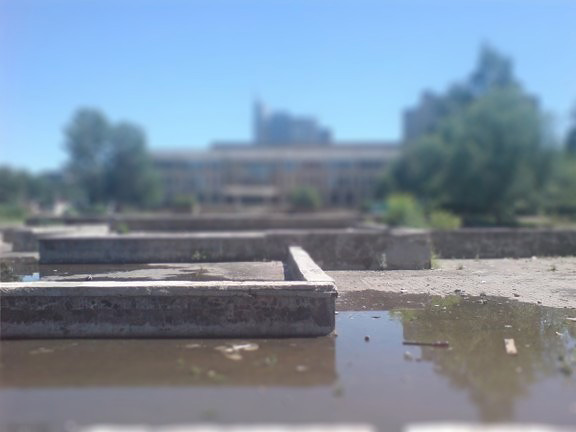
VORONEZH, Russia — Live water heals memories, the American essayist Annie Dillard once claimed. But what of dead water, or boiled water?
The poet who wrote the following lines died in the Gulag:
“Memory is a sickly Jewish girl” (Mandelstam. Egyptian Stamp)
Paradoxically, however, Siberia was not where he was sent for his gravest offense: a poem about Stalin’s “cockroach whiskers”. For that, he was banished from his native St. Petersburg, but allowed to choose the place of his own exile.
Mandelstam chose Voronezh, an old Tsarist city in the south of Russia, on the banks of a tributary of the Don river.
The river was sick. Its waters around Voronezh had become stagnant, a notorious breeding ground for malaria — so much so that by 1913, it was said that not one Voronezh family had avoided succumbing to malaria.
Spraying the mosquitoes from air proved ineffective; thus, on August 14, 1937, the Central Committee of the Communist Party (Bolsheviks) declared that the malaria breeding grounds would be flooded by raising the river’s water level using a dam. The project was entrusted to professors Sergeev, Volkov, Muffel, Kostsov, Dubyansky and Krasnolsky.



“In the rubber tint of boiled St. Petersburg water, I am drinking the unattained domestic immortality” (Mandelstam, Egyptian Stamp)
Forty years after Mandelstam’s death in a Siberian hard labor camp, Mikhail Malik, a retired secret police officer (NKVD), was rewarded by the Soviet state for his services in World War II: he would be allowed to choose the city in which to be issued an apartment.
As an active participant in the lifting of the Siege of Leningrad, he was offered the option to live there. He loved St. Petersburg but felt drawn to a gleaming modern new district that was rising on the left bank of the Don, across the river from the still war-ravaged center of a historic city.
Thus, he too chose Voronezh. But Malik’s new place differed fundamentally from the last city that the living Mandelstam had ever seen: it had gained a sea.
“The Voronezh Sea” is what residents call the 70 square kilometer reservoir that was built in 1972 — 35 years after the Don river had first been dammed.
Did you know? Everyone in Russia was having a great time in the 1970s? People were watching lots of Tarkovsky movies, usually during the work day. They went to hair salons! They got very drunk! They stayed drunk since April 1970, the centenary of Lenin’s birthday. Drunk lumberjacks carved his name in swathes of virgin forest, in gratitude for these sweet lost years. People were comfortable. This is not a story you would hear from dissidents or refuseniks. But most people weren’t refuseniks or dissidents. Malik certainly was neither; Malik held a casual disdain for the Jews.
In the 1970s, everyone just assumed that things would keep ticking along forever. Someone suggested that more factories be built in Voronezh, that the giant artificial rubber factory be expanded, and people nodded in assent; a place was needed for them to draw water from. Drunk surveyors and builders further dammed the Don, and built, badly, an impressive reservoir, with a volume of 204 km³, a length of nearly 50 km, an average width of 2 km, and average depth of 2.9m.
The reservoir was beautiful. It was impossible to think that just some 40 years ago, this area had been a notorious malaria breeding ground. A bold double-decker bridge connected the decrepit, historic old town to the jaunty, radiant, new town. The artificial concrete banks of this man made sea were draped with shiny new sand delivered by truck from Kazakhstan; a beach emerged.
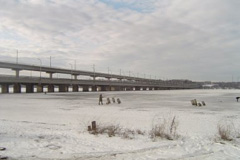
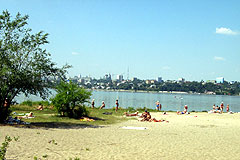
A wide avenue was built, with trams, flanked by multi-storied blocks of apartments with south-facing balconies.
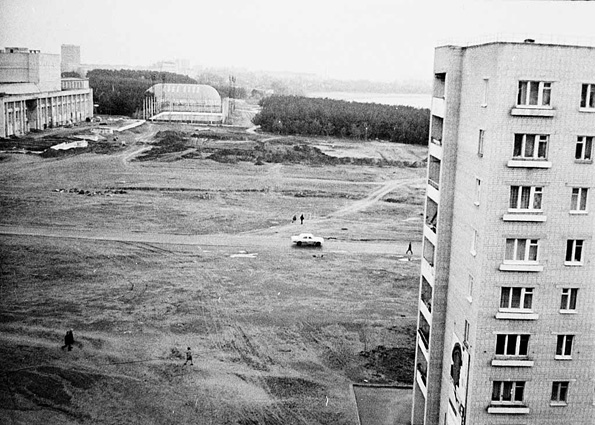
Grandfather Malik’s new apartment was across the street from the beach. Photographs show the author holding a small shovel, as he stands in front of a changing booth near the artificial lighthouse. The beach was named “Dolphin Beach”.
Dolphin Beach was adjacent to Dolphin Park, a children’s amusement park owned by the giant, shadowy Elektronika computer corporation.



Excerpt from an interview with Former Soviet Ambassador to Cuba and Chairman of the RSFSR Council of Ministers (1983-1989) Vitaly Vorotnikov:
“Q: Is that the plant which produced the first Soviet videotape recorders?
A: It did, but they were of little importance. The plant primarily worked for the military.”
The reason there was a park was that the authorities anticipated the beginnings of new families in this new outpost.
Though it was too late for my grandparents to start another family, Malik would wake up at 5 A.M. every morning and go for a brisk morning walk in the park.
What did he pass on his walks?
The shady park, edged off from the road with poplar trees, was planted with pines and conifers and dotted with carved wooden statues of characters from Russian folk tales. In the middle of the park was a miniature racetrack complete with obstacles and road signs on which you could go in a rented pedal car, or even on a small bicycle. There was a booth where you could shoot at tins from a pneumatic rifle.
And all around there were simple amusement rides: spinning spaceships, the “little sun” ride that looks like a windmill, a “centrifuge” (the scariest ride in the park) controlled by portly matrons wearing armbands.
On the other edge of the park, away from the beach, there was a miniature castle, the size of a small house, complete with towers and turrets. Yet its wooden doors were always locked. Next to it was an enormous set of swings: a tower with two oscillating arms attached to a small platform on which up to three older children could sit or stand.
Buffering the playground from the busy road was the Elektronika House of Culture, a sprawling, rectangular concrete building with enormous paneled windows, owned by the Elektronika corporation, that housed cultural events, amateur theater and student music performances. Its wide steps cascaded to a square with a complex of wide, angular fountains.
From the balcony of my grandparents’ 5th floor flat across the road, you could see the House of Culture and its fountains, the pine-tree park behind it, and the reservoir beyond. You would always hear the rattling of the trams as they went over the bridge and to the right bank. Looking directly down from the balcony, you saw, jutting out, the roof of the furniture and hardware store that occupied the ground floor of the building.



“Thirty years had passed, like a slow fire” (Mandelstam, Egyptian Stamp)
The collapse of the USSR crippled Elektronika with a flood of western consumer goods and drastic cuts in its contracts from the defunct and bankrupt military.
With Elektronika’s bankruptcy, the House of Culture became abandoned. Its fountains dried up.
A decade after it hosted the Soviet Rock star Victor Tsoi, the little park had become overgrown and nature had begun to creep in. Slowly, the pedal boat harbor had overgrown with swampy weeds, the fiberglass boats had spung leaks and remained tethered but half submerged in the water, with their little numbers peeling off. The beach café ceased operating. The matronly park attendants were quickly laid off and there was no one to operate or look after the rides. The transport budget was cut, and there was no money to repair the trams. Rails were uprooted for scrap metal, and before long, the bridge fell silent.
Red, red blood
In an hour’s time — there’s just soil
In two hours it sprouts flowers and grass
In three, it’s alive again
Warmed by the rays of a star
Called the sun(Victor Tsoi, “A Star Called the Sun”; author’s translation).
Children continued to play on the defunct rides for some time, pushing each other along in the fiberglass cars along the rusting rails of the “Rocketa,” swinging from the limply flailing limbs of the “Little Sun.”
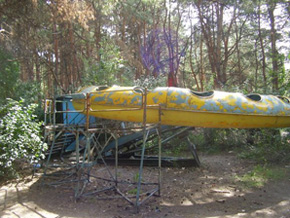
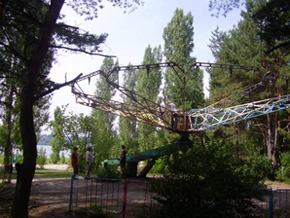
Soon, the children had grown up and began to stage dog fights in the park. No more children took their place, because parents were too frightened to let them near the park, and also, because there were very few children now: a recent article in the Moscow Times revealed that “mortality among Russian men has risen by 60 percent since 1991 and is now four to five times higher than in Europe.”
People began to fall ill. Children playing near the water began to report signs of giardia lamblia, malaria and even cholera.
A water sample from the reservoir at Dolphin Beach was found to contain 5 times the legal limit of contaminants. Cholera traces were also found.
All swimming was banned at the reservoir, but this ban was disregarded by those seeking to assuage the inclement Voronezh heat and catch fish.
It was hard to find fish, because of the high concentration of petrochemical and sewage contamination, much of it coming from the factories which the reservoir was built to service, such as the Artificial Rubber Factory.
“This was an environment built not for man, but for man’s absence.” (Ballard, Highrise)
Warm water returned from these factories bred high concentrations of blue-green algae that killed fish.
New Russians arrived and built McMansions on the bank of the reservoir, but saved money on plumbing and diverted household waste straight into the reservoir.
The slush formed on the bottom of the artificial lake now threatens to slide these houses into the reservoir.
Water from the reservoir began to be introduced into some regional water supplies; its contamination led to heavy chlorination. Some have associated this with an increase in bladder cancer rates. To release the chlorine, boiling this dead water had become essential.
“I propose to you, my family, a coat of arms: a glass of boiled water” (Mandelstam, Egyptian Stamp).
An investigation determined that the reservoir was built too wide and shallow; it was built with significant deviations from design.
Several plans for the city to clean up the bottom of the reservoir, and deepen it, had been rejected for lack of funds.
Elektronika House of Culture had been first sold to Flamingo nightclub, then to a Mitsubishi affiliate, then to a supermarket.



“A lake connected with the moon unveils hidden kinships” — Saint-Exuerry.
Recently, a plan was proposed to sell the House of Culture and Dolphin Park to a developer who would deepen and narrow the reservoir, dry out the shallow areas near the banks, removing the blue-green algae and rescuing prime real estate, at the cost of 50 million euros. That salvaged land would then be converted into a business center and aquapark, with water slides and other amenities, including a Yacht Club:
“The project envisions construction of City-Voronezh on an area of 29 hectares. Development of raised beach territories in the area of the Voronezh water reservoir with simultaneous improvement of the reservoir condition through its deepening is one of the possible solutions to the problem of the shortage of vacant lots for public and residential buildings and recreational territories. The following facilities are planned as part of City-Voronezh: a mixed-use shopping & entertainment center, business center, exhibition center, hotel complex, aquapark, sports and fitness complex, residential complex, administrative building, and yacht club.”
As the magician says to the desperate Ivan Osokin in P.D. Ouspensky’s eponymous novella, “Everything can be brought back. Everything. But even that will not help.” Indeed, when Osokin is granted the power to know everything he knows as an adult and is sent back in time with the chance to correct his past mistakes, he somehow still ends up re-living his original life: “There is something in us that keeps us where we find ourselves. I think this is the most awful thing of all,” he exclaims in agony, on board a ship.


